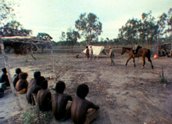


Two Laws (1981)
Synopsis
Two Laws is a documentary made collaboratively by Borroloola Tribal Council and filmmakers Carolyn Strachan and Alessandro Cavadini about the two laws that now exist in this country – colonial law and Indigenous law.
Curator’s notes
Borroloola Tribal Council made Two Laws in collaboration with two white Australian filmmakers, Carolyn Strachan and Alessandro Cavadini. The concept of two laws – being colonial and Indigenous law – can also be spoken about as two ways of storytelling. The film delves into what two laws stand for, two ways of being and two ways of perceiving.
The narrative of Two Laws challenges the conventions of documentary, and occurs more like a conversation. It is loosely constructed and provides the space for stories to occur, rather than being confined to a strict linear structure. Two Laws in this respect is very organic and, at the time that it was made, belongs to an era of 'making films that would express rather than merely observe Aboriginal culture’ (Film Quarterly). Along with Strachan and Cavadini, Two Laws was made by peoples belonging to Mara, Yanula, Garrawa and Gurdandji language groups. It is in four sections: Police Times, Welfare Times, Struggle for Our Land and Living with Two Laws.
Two Laws was produced at the urging of the Borroloola community, its impetus being to explain the Indigenous concept of law. According to Cavadini and Strachan, Two Laws is very much an Aboriginal-structured film due to the people’s unfamiliarity with western storytelling and narrative techniques. Each point in the story is treated with incredible importance, down to the physicality of the people playing parts in the re-constructions. Cavadini and Strachan, who spent time with the community, give a good account of how the story was heavily negotiated. Spatiality was important in how the people themselves perceived the action would unfold before the camera.
The great aspect of this documentary is in how the Indigenous people physically direct each actor, and in doing so convey the intricate details of the story. This detail gives depth to the stories, and conveys the importance of bodies and space to the storytellers. What unfolds in this film is that we ascertain from firsthand accounts the powerlessness Aboriginal peoples were subjected to at the hands of the lawmakers. The essence of the stories being retold is evoked from group conversations, as well as the re-enactments of portions of those stories.
Two Laws is a significant film for those wanting to examine differences in storytelling and filmmaking techniques between Indigenous and non-Indigenous peoples. Two Laws is especially important as a resource on how non-Indigenous filmmakers facilitated the voices of the Indigenous peoples without either party impeding the integrity of the other. Two Laws challenges Western filmmaking conventions. Inherent to the narrative of Two Laws is the very thing the community of Borroloola wished to talk about, the co-existence of two ways of being represented by two ways of telling a story (or making a film), which then can be understood also as Two Laws.
- Overview
- Curator’s notes
- Video 3 clips
- Principal credits
- Find a copy
- Make a comment
- Map
- Add your review



